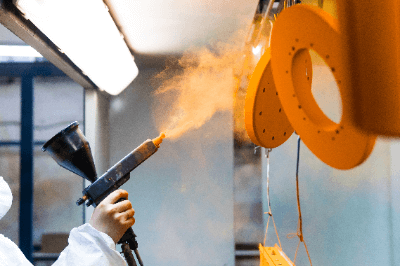What Is Powder Coating?
 Powder coating is a process in which pigments, etc., are ground into a fine powder and sprayed directly onto a metal or other object and heated to form a coating film.
Powder coating is a process in which pigments, etc., are ground into a fine powder and sprayed directly onto a metal or other object and heated to form a coating film.
This coating method is called powder coating. The coating film is characterized by its strength, elasticity, and high corrosion resistance.
In contrast to solvent coating, in which pigments are generally dissolved in a solvent such as thinner and applied, powder coating does not use solvents. Therefore, the risk of environmental pollution, health hazard, fire, etc. is low.
Uses of Powder Coating
Powder Coating is used for a wide variety of industrial products, including metal coatings.
Examples of specific applications are as follows:
- Automobile and motorcycle parts
- Steel furniture
- Exterior products
- Guardrails
- Road signs
- Washing Machines
- Refrigerators
- Personal computers
- Electricity meter
- Bicycles
- Park playground equipment
- Water pipe
- Tractor
Principle of Powder Coating
There are two methods of spraying powdered paint to adhere to a coated object: electrostatic powder coating (spray coating) and fluidized dip coating (dip coating). In general, electrostatic powder coating using thermosetting paints is the most common method, so this section describes the electrostatic powder coating method.
In the electrostatic powder coating method, the paint is charged negatively (-) in atomized form and the object to be coated is charged positively (+), and the paint is sprayed onto the object to be coated electrically. The paint is charged to the negative electrode either by the corona method, in which voltage is applied to electrodes inside the spray gun that discharges the paint, or by the triboelectric method, in which static electricity is generated by the friction of the powdered paint as it passes inside the gun. The object to be coated is grounded and charged to the positive electrode.
After the coating is applied, it is heated at 180 to 200 degrees Celsius, which causes the powder to melt and undergo a chemical reaction, forming a coating film. The chemical reaction forms a network-like structure of high-molecular polymers, making the coated material less susceptible to air and providing excellent corrosion protection.
The work process of Powder Coating is as follows: pretreatment → draining and drying → powder coating → baking and drying → inspection.
Characteristics of Powder Coating
- The thick coating film and high strength of the coating film itself make it scratch-resistant and excellent in heat resistance and oil resistance.
- High elasticity prevents cracking and peeling, and prolongs the life of the coating.
- The coating film is thick and has few pinholes, making it difficult for the coated object to come into contact with air, and thus has high corrosion prevention capability.
- The coating does not contain VOCs (Volatile Organic Compounds), which cause environmental pollution, or solvents that may cause sick building syndrome and risk ignition.
- The high durability and anti-corrosion capability of the product reduces the number of re-coatings, resulting in low running costs.
- In addition, the paint can be recovered and reused with little loss, and the painting line can be downsized and automated easily, resulting in a high cost advantage for the painter and lower prices.
- After heating, it can be combined with other parts as soon as the temperature drops.
Other Information on Powder Coating
How to Improve the Adhesion of Powder Coating
Powder Coating is used because of its heat resistance, oil resistance, elasticity, and corrosion resistance, but in order for it to perform well, it is important that it adheres to and covers the coated object well. To improve adhesion, pretreatment and draining and drying before powder coating are important.
First, alkaline degreasing is performed to remove oil components from the coated surface, pickling to remove rust, and conversion treatment to produce a zinc phosphate film. The purpose of the conversion treatment is to remove impurities from the coated surface and to form a dense film with high rust-preventive properties.
After the conversion treatment, the coated surface becomes wet by rinsing, but if powder coating is performed with moisture remaining on the surface, blistering is likely to occur after the coating. Therefore, water should be completely removed before coating.